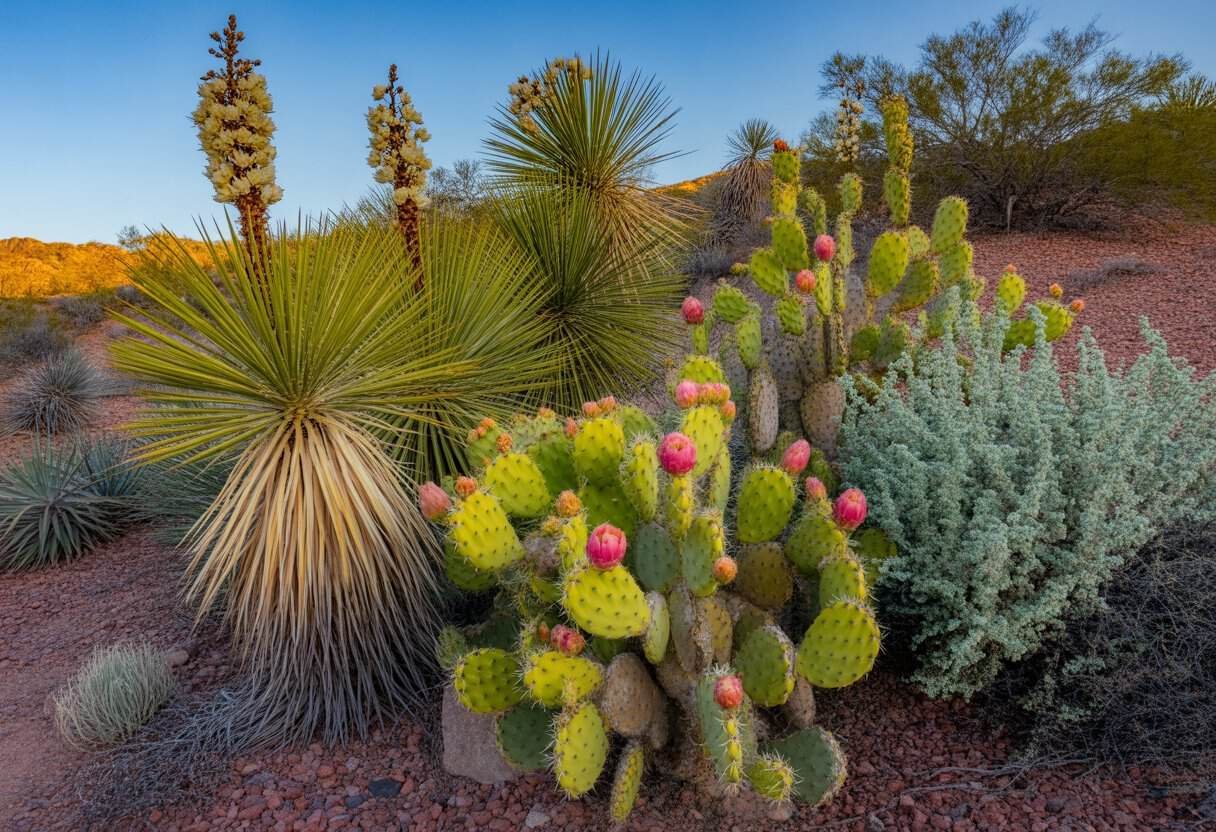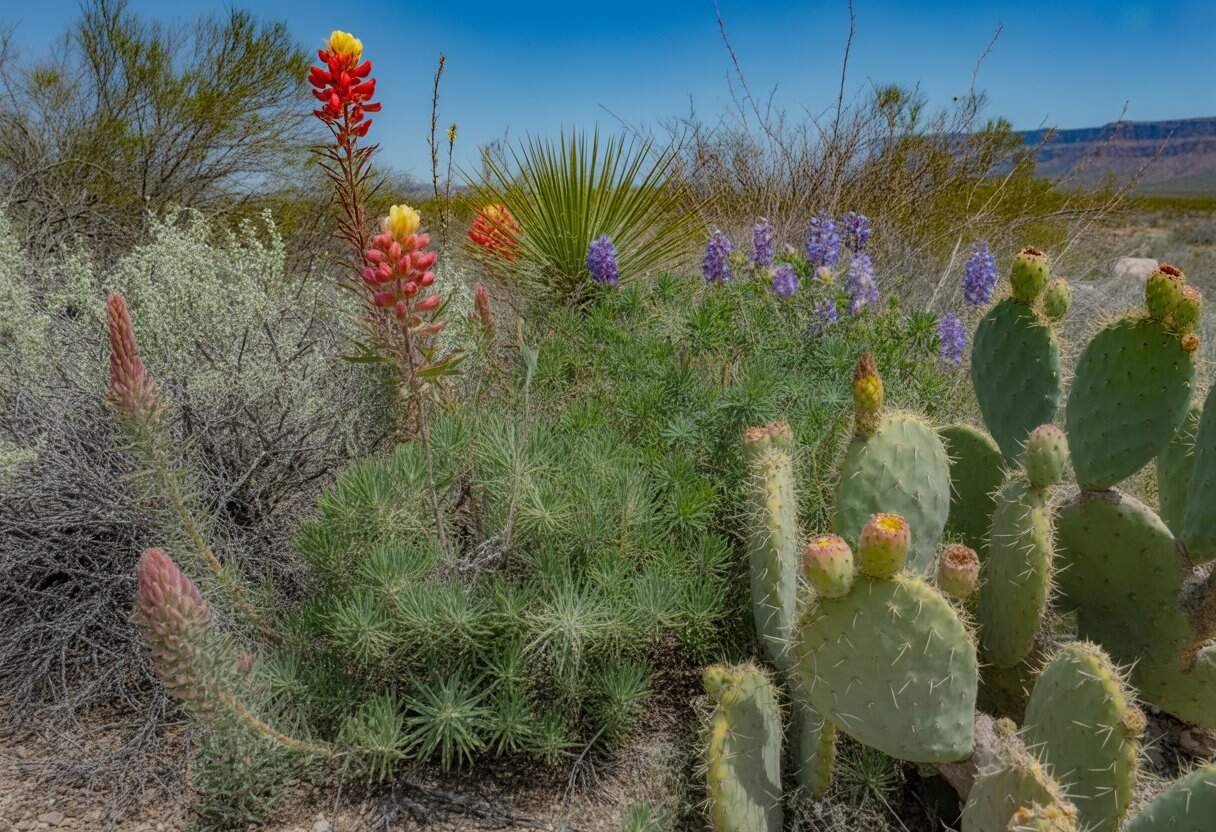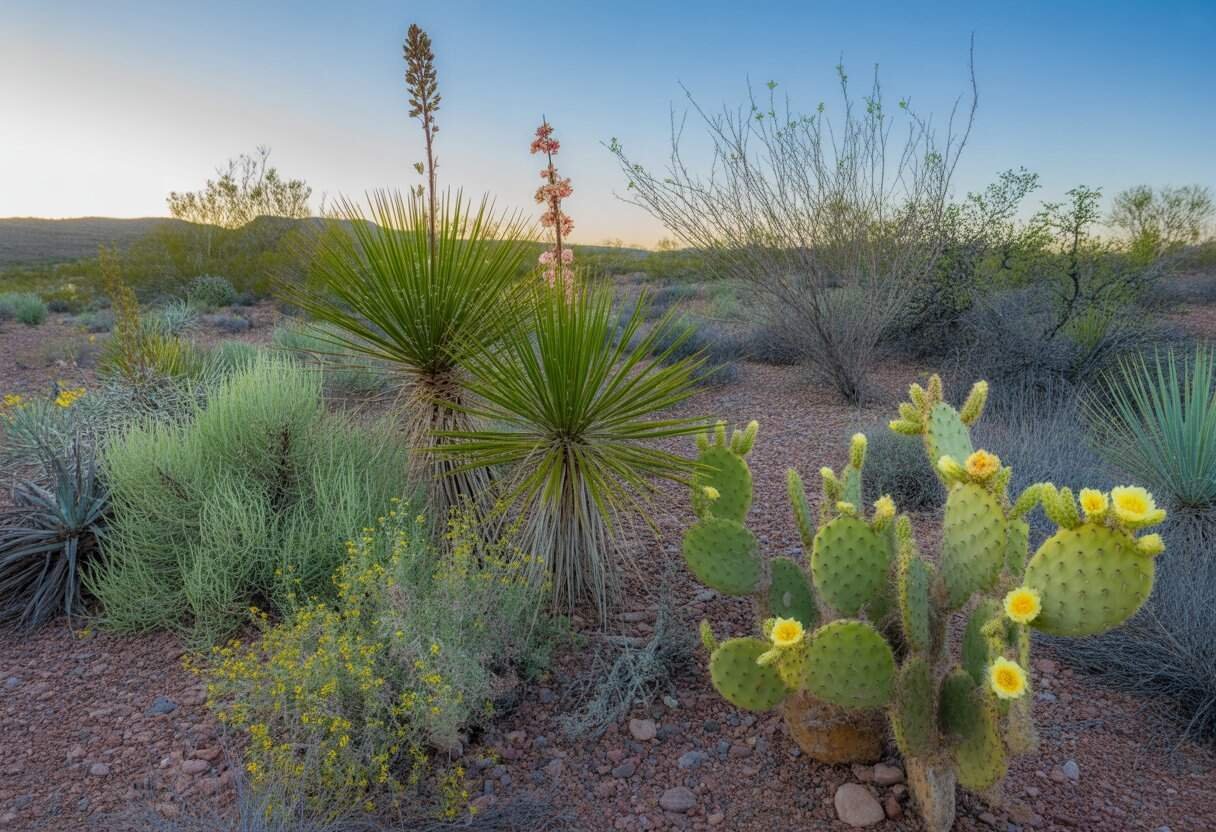New Mexico’s landscape is home to a diverse range of native plants that thrive in its unique climate. From colorful wildflowers in the desert to sturdy trees in the mountains, these plants tell the story of adaptation and resilience.
Native plants in New Mexico need less water and maintenance than non-native species. They support local wildlife and help preserve the region’s natural heritage.

The state’s varied elevations and climate zones create distinct plant communities. In the southern deserts, you’ll find cacti and yuccas.
The northern mountains support ponderosa pines and aspen groves. The middle-elevation areas feature piñon-juniper woodlands that have sustained local communities for centuries.
Key Takeaways
- New Mexico native plants are adapted to local conditions, requiring less water and maintenance than non-native species.
- Different plant communities exist across the state’s varied elevations and climate zones, from desert cacti to mountain forests.
- Using native plants in landscaping helps support local pollinators, conserves water, and preserves New Mexico’s natural heritage.
Overview of New Mexico Native Plants
New Mexico’s native plants have evolved unique adaptations to thrive in the state’s diverse landscapes. These resilient species form the backbone of local ecosystems and showcase remarkable biodiversity.
Definition and Characteristics
Native plants in New Mexico evolved naturally in the region without human introduction. These plants have specialized adaptations to survive challenging climate conditions, including drought tolerance, deep roots, and water-conservation mechanisms.
Many native species have waxy coatings on leaves to reduce water loss. Others have small, narrow leaves that minimize sun exposure.
Some plants, like the yucca, store water in thick, fleshy leaves or stems. New Mexico’s native flora includes colorful wildflowers such as desert marigold and chocolate flower, as well as iconic trees like piñon pine and ponderosa pine.
Cacti varieties, including prickly pear and cholla, add to the Land of Enchantment’s botanical diversity.
Geographic Distribution
New Mexico’s native plants grow across six distinct ecological zones. Each zone supports different plant communities:
Lower Sonoran Zone (3,500-4,500 ft): Features desert plants like creosote bush, mesquite, and various cacti.
Upper Sonoran Zone (4,500-7,000 ft): Home to juniper, piñon pine, and drought-resistant shrubs.
Transition Zone (7,000-8,500 ft): Contains ponderosa pine forests mixed with Gambel oak and mountain mahogany.
Canadian Zone (8,500-9,500 ft): Dominated by Douglas fir, white fir, and aspen groves.
The state’s varied topography creates many microhabitats for specialized plant communities. Riparian areas along rivers support cottonwoods and willows.
High alpine meadows host delicate wildflowers that bloom during brief summer seasons.
Role in the Local Ecosystem
Native plants form the foundation of New Mexico’s ecosystems. They provide food and shelter for wildlife, from large mammals to countless insects.
Many plants have special relationships with native pollinators. These plants help prevent soil erosion with their extensive root systems.
During heavy rains, native vegetation slows water runoff and allows moisture to soak into the soil. Native species support biodiversity conservation and rarely become invasive.
They typically need minimal resources to thrive. Some native plants hold cultural significance for indigenous communities, who use them for food, medicine, and ceremonies.
Examples include:
- Four-wing saltbush: Used for food and medicine
- Osha: Valued for respiratory treatments
- Bear grass: Important for basket weaving
Common Types of Native Plants in New Mexico

New Mexico’s diverse landscapes support a rich variety of native plants. These plants thrive with minimal water and provide important habitat for local wildlife.
Cacti and Succulents
The desert regions of New Mexico host many cacti and succulents adapted to harsh conditions. Cholla cactus stands out with cylindrical segments and barbed spines, creating habitat for desert wildlife.
These plants bloom with colorful flowers in spring. Agave species, such as Agave parryi (Parry’s agave), have thick, blue-gray leaves ending in sharp tips.
Agave stores water efficiently and produces a tall flowering stalk once in its lifetime. Yucca plants, with sword-like leaves, are iconic New Mexico natives.
The yucca is the state flower and relies on the yucca moth for pollination. Native Americans have used yucca for fiber in baskets and rope.
Trees and Shrubs
New Mexico’s native trees and shrubs shape many ecosystems. Ponderosa pine dominates higher elevations with tall trunks and vanilla-scented bark.
These trees can live for hundreds of years and provide essential wildlife habitat. Piñon pine and various junipers create woodland habitats at middle elevations.
Piñon trees produce edible nuts for humans and wildlife. These drought-resistant trees need little water once established.
Desert willow offers beautiful trumpet-shaped flowers that attract hummingbirds. Mesquite thrives in southern regions with deep taproots that access groundwater.
Cottonwood trees (Populus fremontii and Populus deltoides) grow along waterways, providing crucial shade and habitat. Sagebrush covers many areas with silver-gray foliage and a distinctive aroma.
Bearberry (Arctostaphylos uva-ursi) forms low mats with small, leathery leaves and red berries.
Wildflowers and Grasses
New Mexico’s wildflowers create spectacular seasonal displays. Indian blanket produces red flowers with yellow edges and thrives in full sun and poor soils.
These drought-tolerant plants attract butterflies and other pollinators. Purple poppy mallow (Callirhoe involucrata) spreads low to the ground with magenta cup-shaped flowers.
This plant blooms throughout summer and needs little water. Indian hemp grows in disturbed areas and produces small white flowers followed by slender seed pods.
Native grasses like blue grama, buffalo grass, and galleta evolved to withstand grazing and drought. These wildflowers and grasses prevent soil erosion, provide food for pollinators, and create shelter for small animals.
Many species go dormant during drought and rebound quickly after rain.
Adapting to New Mexico’s Environment

New Mexico’s unique climate and geography create specific challenges for plants. Native species have developed remarkable adaptations to thrive in these conditions.
Drought Tolerance
Native New Mexican plants show impressive drought tolerance. Many species, like Apache plume and desert willow, grow deep root systems that reach water far below the surface.
These roots often spread wider than the plant’s canopy. Some plants, such as agave and yucca, store water in thick, fleshy leaves or stems.
This adaptation helps them survive long periods without rain. Many native species also have features to reduce water loss:
- Small leaves – Reduce evaporation
- Waxy coatings – Block water loss
- Gray or silver foliage – Reflect sunlight and lower heat absorption
- Summer dormancy – Some plants rest during the hottest months
Hardiness Zones
New Mexico covers several USDA hardiness zones, from zone 4 in the northern mountains to zone 8 in the south. This diversity offers many planting options.
Northern regions experience colder winters, where plants must withstand temperatures as low as -30°F. Native conifers like Ponderosa pine and Rocky Mountain juniper thrive in these areas.
Central New Mexico is generally zones 6-7, with temperature extremes in summer and winter. Apache plume and desert willow adapt well to these fluctuations.
Southern areas have milder winters but intense summer heat. Desert plants like ocotillo and creosote bush handle these conditions well.
Water Needs
Native New Mexican plants have modest water requirements compared to non-native species. Once established, many need little supplemental irrigation beyond rainfall.
Most native plants benefit from deep, infrequent watering. This approach encourages deeper root growth and greater drought resistance.
Water needs by plant type:
| Plant Type | Establishment Period | Long-term Needs |
|---|---|---|
| Desert/Xeric | 1-2 years of occasional watering | Rainfall only |
| Mid-range | 1-2 years of regular watering | Occasional during drought |
| Riparian/Mesic | Regular watering | Consistent moisture |
Plants like chocolate flower and desert marigold survive on 8-10 inches of annual precipitation. Riparian species like cottonwoods need reliable water sources nearby.
Ecological Benefits of Native Plants
Native plants of New Mexico support local ecosystems. These plants have evolved alongside local wildlife and environmental conditions for thousands of years.
Supporting Local Wildlife
Native plants provide essential food and shelter for New Mexico’s wildlife. Many local birds, mammals, and reptiles depend on specific native plants for survival.
Piñon trees produce nutritious seeds that feed birds and small mammals. Desert willow and New Mexico olive trees create shelter for birds and small animals.
These plants offer protection from predators and harsh weather. Native grasses like blue grama and buffalo grass provide nesting materials for birds and cover for small ground animals.
Their deep roots stabilize soil and prevent erosion. Yucca plants rely on yucca moths for pollination, showing a unique co-evolution.
Biodiversity and Pollinators
Native plants boost biodiversity by supporting many pollinators and insects. New Mexico’s native plants attract bees, butterflies, and hummingbirds that ensure plant reproduction.
Hummingbird mint (Agastache) attracts pollinators with tubular flowers and a strong scent. One hummingbird mint plant can support dozens of pollinator species.
Native sunflowers provide nectar and pollen for bees, while their seeds feed birds and small mammals. These plants support complex food webs.
Desert marigold and chocolate flower attract specialized native bee species. These relationships increase biodiversity and make ecosystems more resilient.
Using New Mexico Native Plants in Landscaping
Native plants create beautiful, water-efficient landscapes that support local wildlife. They need less maintenance and showcase New Mexico’s unique natural heritage in your yard.
Design Principles and Best Practices
When designing with native plants, start by considering your property’s natural conditions. Group plants with similar water needs together—a practice called hydrozoning.
Hydrozoning prevents overwatering drought-tolerant species and ensures thirstier plants get enough moisture. Create layers in your landscape by combining different plant heights.
Use ground covers like blue grama grass. Add mid-height plants such as penstemons and salvias.
Include taller shrubs like apache plume and chamisa. Plant trees such as piñon pine or desert willow for additional height.
Leave space between plants at first. Native plants often grow to fill their natural space over time.
Home Depot now carries more native plant options. This makes them easier to find than in previous years.
Minimize soil amendments. Most New Mexico natives prefer the lean, native soils they evolved in.
Popular Choices for Home Gardens
These native plants thrive in New Mexico home landscapes:
For Sunny Areas:
- Desert marigold (Baileya multiradiata) – bright yellow flowers
- Chocolate flower (Berlandiera lyrata) – morning chocolate scent
- Blue grama grass (Bouteloua gracilis) – drought-resistant lawn alternative
For Partial Shade:
- Coral bells (Heuchera sanguinea) – delicate red flowers
- Columbine (Aquilegia chrysantha) – yellow blooms in spring
Desert willows offer beautiful trumpet-shaped flowers and dappled shade. Agaves and yuccas create bold architectural elements with minimal water use.
Many flowering natives attract pollinators and turn gardens into wildlife havens. Apache plume adds year-round interest with spring flowers and feathery pink seedheads that last through winter.
Conservation and Sustainable Practices
Protecting New Mexico’s native plants requires focused conservation and restoration work. These efforts help maintain the state’s unique biodiversity.
Preservation Efforts
Several organizations work to protect New Mexico’s native plant species. The Native Plant Society of New Mexico leads educational programs to raise awareness about the importance of indigenous plants.
State parks and reserves create protected spaces where native species can grow undisturbed. These areas serve as living museums of New Mexico’s botanical heritage.
Seed banks throughout the state collect and preserve native plant genetic material. This work ensures that even rare species have a chance at survival if wild populations decline.
Conservation easements allow private landowners to protect native plant habitats on their property. These legal agreements prevent development while allowing traditional land uses to continue.
Restoration Projects
Restoration efforts return damaged landscapes to their natural state. After wildfires, teams replant native species to prevent erosion and invasive plant takeover.
The Rio Grande bosque restoration project targets riparian areas. Workers remove non-native species like salt cedar and Russian olive, replacing them with native cottonwoods and willows.
Community volunteers participate in many restoration projects. They remove invasive species, collect seeds, and plant native vegetation in disturbed areas.
Scientists monitor restored areas to measure success and adapt techniques. This research helps improve future restoration work throughout New Mexico.
Native plant nurseries grow local species for restoration projects. These growers ensure that plants are genetically appropriate for the specific ecosystem where they’ll be planted.
Challenges and Future of Native Plants in New Mexico
New Mexico’s native plant species face significant obstacles despite their adaptation to the harsh desert environment. These challenges include human development and climate shifts that threaten their survival.
Threats and Invasive Species
Invasive species pose one of the biggest threats to New Mexico’s native plants. Russian thistle (tumbleweed), salt cedar, and cheatgrass outcompete native species for limited water and nutrients.
These aggressive invaders quickly transform ecosystems and displace indigenous plants. Urban development fragments natural habitats across New Mexico.
As cities like Albuquerque and Santa Fe expand, native plant communities become isolated in smaller patches. Overgrazing by livestock has damaged many grassland areas, reducing the presence of native grasses like blue grama and buffalo grass.
These practices have allowed invasive species to gain footholds in disturbed areas. Mining and energy development also contribute to habitat loss.
Open pit mines and oil drilling operations remove native vegetation that may take decades to recover, if at all.
Climate Change Impact
Rising temperatures in New Mexico shift the viable ranges for many native plants. Species adapted to specific elevation zones must migrate upward as their traditional habitats become too warm.
Drought conditions are becoming more frequent and severe across the state. Even drought-adapted plants like cacti and yuccas face challenges when dry periods last too long.
Changing precipitation patterns affect flowering times and seed production for many native species. When plants flower too early or too late, they may miss crucial pollinator interactions.
Extreme weather events, including more intense wildfires, threaten established plant communities. Post-fire landscapes often favor fast-growing invasive species over slower-growing natives like piñon pine and juniper.
Frequently Asked Questions
New Mexico’s native plants offer unique benefits for local landscaping and ecological restoration. These plants have adapted to the state’s diverse climate conditions and soil types over thousands of years.
How can one identify native plants in New Mexico?
Native plants in New Mexico have distinctive features adapted to the local climate. Look for drought-resistant traits such as small, waxy leaves or deep taproots.
Field guides specific to the Southwest region provide detailed descriptions and photos. The New Mexico Native Plant Society offers identification resources through their website and local chapters.
Plant identification apps like iNaturalist can help beginners identify native species. These tools use photo recognition technology and connect users with local botanical experts.
Which native plants are suitable for landscaping in New Mexico’s climate?
Apache Plume thrives in New Mexico’s arid conditions and produces feathery pink seed plumes. Desert Willow offers beautiful trumpet-shaped flowers and provides partial shade in yards.
Penstemons add vibrant color with minimal water requirements. Blue grama grass forms attractive clumps that require little maintenance and add texture to landscapes.
Drought-tolerant shrubs like Chamisa (Rabbitbrush) and Four-wing Saltbush work well in xeriscaped yards. These plants support local pollinators and conserve water.
Where can I find a map detailing the distribution of native plants in New Mexico?
The SEINet Portal Network provides interactive maps showing plant distributions across New Mexico. Users can search by species to view current and historical records.
The New Mexico Biodiversity Collections Consortium maintains detailed distribution maps. Their database combines information from herbarium specimens and field observations.
The USDA PLANTS Database offers range maps for native species throughout the state. These resources help gardeners understand which plants naturally occur in their region.
What are some commonly found shrubs native to New Mexico?
Big Sagebrush dominates many New Mexico landscapes with its silver-gray foliage and aromatic scent. Creosote Bush covers large areas of southern New Mexico’s desert regions.
Apache Plume features showy pink seedheads that persist through winter. Three-leaf Sumac provides brilliant red fall color and edible berries used traditionally by indigenous peoples.
New Mexico Olive (Forestiera neomexicana) produces small dark fruits that attract birds. Mountain Mahogany offers unique feathery seed structures and helps control erosion on slopes.
Where can one purchase native plants in New Mexico for gardening or landscaping purposes?
Plants of the Southwest maintains nurseries in Santa Fe and Albuquerque specializing in native species. They offer seeds, starter plants, and expert advice for local gardeners.
The Albuquerque BioPark hosts seasonal native plant sales supporting conservation efforts. Many county extension offices organize annual native plant sales in spring and fall.
Local chapters of the Native Plant Society hold plant exchanges and sales. Some conventional nurseries now dedicate sections to regionally appropriate native plants.
Can you list some native flowers and plants that are unique to New Mexico?
The New Mexico Thistle (Cirsium neomexicanum) displays striking purple flowers found nowhere else.
The Sacramento Mountains Prickly Poppy has large white flowers with yellow centers.
The Organ Mountains Evening Primrose opens delicate yellow blooms at dusk.
This species grows in southern New Mexico’s mountain ranges.
The McGaffey’s Penstemon shows off tubular blue flowers.
It grows only in northwestern New Mexico.
The New Mexico Vervain produces delicate purple flower spikes in summer and early fall.


